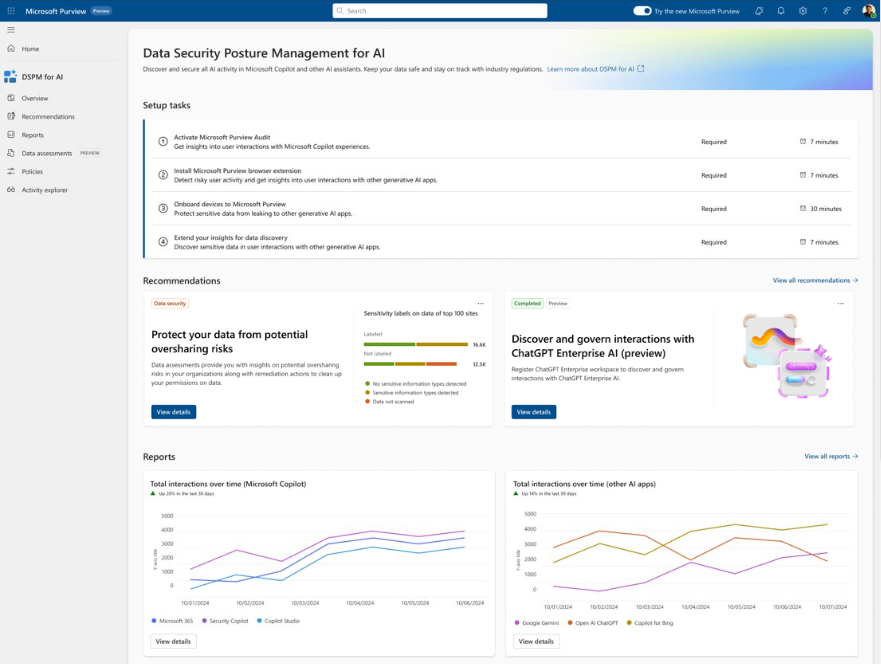Governance Takes Center Stage
Microsoft brought the conversation on AI from innovation to accountability. Among the biggest announcements was the launch of Microsoft Purview Data Security for Generative AI Apps — a blueprint for responsible AI governance.
As copilots and AI agents embed themselves across every workflow, enterprises are asking a new kind of question: Can we trust what our AI knows? Microsoft’s update to Purview reframes the answer by turning governance into a living system — one that not only protects data but explains every AI interaction in detail.
Purview now sits at the heart of the enterprise AI stack. It unifies visibility, security, and compliance under one operational control plane — ensuring that AI systems act within the boundaries of policy, ethics, and regulation.
“AI doesn’t just need guardrails — it needs governance built into its DNA.Microsoft’s approach with Purview turns compliance into confidence.”
— Gaurav Agarwaal
My Pick of Top Announcements: Where Data Meets Responsible Intelligence
Data Security Posture Management (DSPM) for AI: From Visibility to Control
The cornerstone of Microsoft’s announcement is Data Security Posture Management (DSPM) for AI — the new command center for understanding how AI interacts with enterprise data. DSPM brings together protection, compliance, and analytics under one interface.
It allows organizations to track every AI interaction across Microsoft 365 Copilot, Security Copilot, Copilot in Fabric, Azure AI Foundry, and even third-party platforms like ChatGPT Enterprise and Gemini.
Administrators can now discover AI prompts and responses, detect potential data exposure, and enforce policy-based remediation in real time.
DSPM shifts governance from an annual compliance exercise to a continuous, intelligence-driven discipline — embedding oversight directly into the AI workflow.
Sensitivity Labels and Encryption: Zero Trust, Now for AI
Microsoft has extended its proven information protection model into the AI layer. When a document or dataset carries a Confidential or Highly Confidential label, that protection travels with it — even when Copilot or other AI tools access it.
AI models are now subject to the same encryption and rights management rules as humans. Before an AI can summarize or surface content, it must validate the VIEW and EXTRACT permissions tied to the sensitivity label.
This evolution of Zero Trust for AI ensures that copilots cannot expose data a user isn’t authorized to see — enforcing security at the level of reasoning itself.
“Zero Trust used to mean who could log in. In the age of AI, it means what the system is allowed to infer.”
— Gaurav Agarwaal
Data Loss Prevention (DLP) for AI Workflows: Protecting the Prompt Boundary
Generative AI has moved the data perimeter from files to conversations — from storage to prompts. Microsoft Purview Data Loss Prevention (DLP) now extends directly into that new frontier.
With endpoint DLP, users are prevented — or warned — when attempting to paste sensitive data into third-party AI tools. Within Microsoft 365 Copilot, DLP can restrict AI from summarizing Highly Confidential content while still allowing secure referencing.
This ensures that AI remains productive without crossing compliance boundaries. Data protection now lives where decisions happen — at the prompt level.
Insider Risk Management for AI: Aligning Human and Machine Behavior
As AI becomes a collaborator, internal risk becomes more complex. Purview Insider Risk Management for AI introduces advanced detection capabilities that monitor both human and model behaviors.
It can identify activities such as prompt injection, sensitive data extraction attempts, or abnormal query patterns. These signals integrate directly with Microsoft Defender XDR, offering security teams unified visibility across the enterprise.
Built on principles of pseudonymization and role-based access, this framework safeguards privacy while maintaining oversight. It’s governance that respects boundaries — human and digital alike.
“Security without privacy isn’t trust — it’s surveillance. True governance protects people as much as data.”
— Gaurav Agarwaal
Auditability and Compliance: Making AI Explainable by Design
Transparency is the new foundation of enterprise trust. With this update, Microsoft has embedded explainability and accountability directly into the heart of Purview’s AI governance model. Every Copilot interaction — from prompts and responses to data references — is now captured in the Unified Audit Log and surfaced through Activity Explorer in Data Security Posture Management (DSPM) for AI. This creates a continuous audit trail that makes AI decisions traceable and defensible.
But Microsoft’s approach goes beyond tracking — it embraces the principles of Explainable AI (XAI). In this framework, governance doesn’t just record what AI did; it helps explain why it did it. Auditable insights now serve four key purposes: to justify predictions, discover bias, drive accountability, and enable improvement across AI systems.
Through integration with eDiscovery, Communication Compliance, and Data Lifecycle Management, organizations can retain, review, or delete AI interaction data based on regulatory or ethical requirements. This ensures that AI no longer operates as a black box but as a governed, explainable system of record — one where every inference, output, and correction can be justified and improved upon.
“Transparency isn’t about seeing everything — it’s about understanding why decisions were made. Explainability turns AI from a mystery into a mechanism of trust.”
— Gaurav Agarwaal
Compliance Manager for AI: Bridging Innovation with Regulation
As global AI laws take shape — from the EU AI Act to NIST’s AI Risk Management Framework — Microsoft Purview’s Compliance Manager provides enterprises with a proactive way to align innovation with regulation.
It offers prebuilt templates for AI-specific assessments, allowing organizations to benchmark their posture, track control effectiveness, and generate auditor-ready evidence automatically. This transforms compliance from a static checklist into a continuous readiness function — built into the same system that secures the data itself.
“Regulation shouldn’t be a roadblock to AI — it should be the roadmap. Compliance Manager gives leaders that roadmap.”
— Gaurav Agarwaal
Enterprise Impact — The Convergence of Security, Privacy, and Intelligence
The real story behind Microsoft’s Purview evolution isn’t just about new controls — it’s about strategic convergence. What began as separate domains of security, compliance, and data protection has now merged into a single, intelligent governance fabric. Microsoft Purview no longer functions as a collection of tools; it acts as an adaptive ecosystem where protection, privacy, and productivity reinforce each other in real time.
By embedding Data Security Posture Management (DSPM), Data Loss Prevention (DLP), Insider Risk Management, and Compliance Manager directly into the AI layer, Microsoft has transformed governance from a supporting process into the core infrastructure of trusted intelligence. Every AI interaction — every prompt, summary, and response — is now policy-aware and automatically auditable.
For enterprises, this convergence is liberating. It means they can scale AI responsibly — achieving speed without sacrificing control, and innovation without eroding trust. In this new model, governance isn’t a brake on transformation; it’s the engine that powers it.
“In mature AI enterprises, security and innovation no longer compete — they converge.Governance becomes the invisible architecture of progress.”
— Gaurav Agarwaal
What CXOs Should Do Next (Prescriptive)
- Operationalize DSPM for AI.
Make it your organization’s AI observatory — the source of truth for visibility and risk posture. - Extend sensitivity labeling and encryption across data estates.
Ensure that every dataset and AI interaction carries its governance metadata. - Redefine DLP for prompts and agents.
Build guardrails around AI workflows, not just files. - Integrate Insider Risk for AI.
Use behavior analytics to bridge human oversight with model transparency. - Adopt Compliance Manager’s AI frameworks.
Get ahead of emerging regulations through automation, not manual audits.
Governance is no longer an afterthought — it’s a competitive differentiator.
Enterprises that can prove their intelligence is trusted will win the confidence of customers, regulators, and partners alike.
Final Reflection: From Governed Data to Governed Intelligence
Microsoft’s 2025 Purview expansion represents more than a product evolution; it’s a philosophical statement about the future of enterprise AI.
For years, organizations built systems that were intelligent but opaque. Now, they have the tools to make those systems accountable. With DSPM, DLP, Insider Risk Management, and Compliance Manager unified under one architecture, governance becomes an enabler — not an obstacle — to innovation.
“The enterprises that thrive in the AI era will be the ones that can explain their intelligence — not just deploy it.”
— Gaurav Agarwaal
Views: 3.2K

